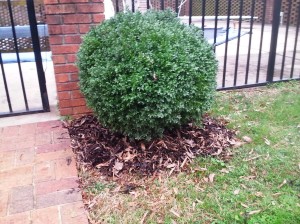As you drive along Sharon Road in Charlotte you will notice several mature Willow Oak Trees that line the road. These trees were originally planted as part of the Morrison farm and estate, back at the turn of the last century. What was once a farm is now called South Park. Yes, South Park Mall and much of its commercial and residential areas were once sprawling farmland. These trees originally lined the once country lane called Sharon Road. Shrub Doctor was recently asked to assess the health of four of these mature trees. Shrub Doctor recommended that the trees first be pruned of all dead and dying limbs. After the trees were pruned, rich organic nutrients were provided to each tree via deep root fertilization. Our mature trees are a Charlotte treasure yet they are undergoing severe stress due to drought, overcrowding, canker worms, and damages brought on by construction. Shrub Doctor has addressed this problem with its annual fertilization program, where these mature trees are supplied with rich organic nutrients each year. Shrub Doctor has ISA Certified Arborists on staff to assess the heath of your trees. Contact Shrub Doctor today to learn more about how your trees can receive our personal care and special attention so they will continue to provide you joy in the generations ahead.
Posted in Around Your Neighborhood | Tagged canker worms, Canker worms in Charlotte, certified arborist charlotte, Certified ISA arborist, Charlotte arborist, Charlotte tree health, Charlotte trees, Deep Root Fertilization, Myers Park Oaks, Myers Park Trees | Leave a Comment »
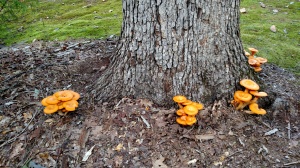 Shrub Doctor was called assess the health of this oak tree yesterday. Normally mushrooms and fungal conks growing at the base of a tree indicate advanced stages of root decay. In this case, the tree was in perfect health.
Shrub Doctor was called assess the health of this oak tree yesterday. Normally mushrooms and fungal conks growing at the base of a tree indicate advanced stages of root decay. In this case, the tree was in perfect health.
These Jack O’lantern mushrooms are actually living off of the decaying mulch and leaf debris surrounding the tree. Jack O’lantern mushrooms get their name from the strange glow that is emitted from their underbelly. Jack O’lantern mushrooms contain a substance similar to that of a lightning bug, causing the areas around the mushroom to emit a faint glow in darkness.
If you see mushrooms growing around the base of your trees, call Shrub Doctor immediately. Not all assessments of basal fungi end in good news. Our ISA Certified Arborists will provide you a clear and accurate assessment of your trees so you will have a better understanding of the health of your landscape.
Posted in Around Your Neighborhood | Tagged Ballentyne trees, certified arborist charlotte, Charlotte NC trees, charlotte street trees, Charlotte tree and shrub care, Charlotte tree health, Charlotte trees, Deep Root Fertilization, Myers Park Oaks, Myers Park Trees, Shrub Doctor, Tree fungus | Leave a Comment »
Shrub Doctor was recruited by a large church in Huntersville, NC to save the maple trees on their campus. Shrub Doctor identified 72 trees that were suffering from dehydration, lack of nutrition, and advanced infestation of gloomy scale insects. These trees are installed within the small islands of the campus parking areas. Excessive heat and lack of moisture has caused severe decline, requiring several trees to be removed prior to treatment. Shrub Doctor immediately recommended a routine watering schedule to assure proper hydration followed by a three-step restoration treatment. A 1000 gallon watering truck has been acquired by the church to begin a scheduled watering program. Last week Shrub Doctor performed restoration treatments to the trees including deep root fertilization, treatments to kill insect infestations, and treatments to regulate the future growth of the trees. Going forward, the church volunteers will follow Shrub Doctor’s watering and fertilization recommendations to help their trees make a full recovery.
Posted in Around Your Neighborhood, Organic Plant Health, Sustainable organic shrub care, Watering | Tagged certified arborist charlotte, Certified ISA arborist, Charlotte arborist, Charlotte tree and shrub care, Charlotte trees, Deep Root Fertilization, Lake Norman Shrubcare, Landscape neglect, Shrub and tree care Charlotte, Shrub Doctor Charlotte | Leave a Comment »
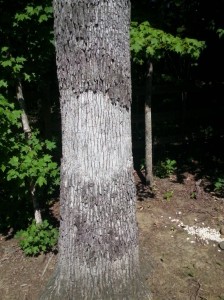 Shrub Doctor noticed a good example of smooth patch fungus activity on this tree today. Also known as white patch, this fungus decomposes the corky outer bark layer of the tree. Since the patch fungus only invades the nonliving outer bark tissues, no harm is done to the tree. Smooth patch is one of many natural occurrences that can be found in our landscapes. No treatments are needed, and your tree should recover over the future seasons. If you notice concerns with your trees and shrubs within your landscape give Shrub Doctor a call. One of our ISA Certified Arborists will be glad to schedule a visit and provide solutions that will keep your plants healthy and vigorous for many years to come.
Shrub Doctor noticed a good example of smooth patch fungus activity on this tree today. Also known as white patch, this fungus decomposes the corky outer bark layer of the tree. Since the patch fungus only invades the nonliving outer bark tissues, no harm is done to the tree. Smooth patch is one of many natural occurrences that can be found in our landscapes. No treatments are needed, and your tree should recover over the future seasons. If you notice concerns with your trees and shrubs within your landscape give Shrub Doctor a call. One of our ISA Certified Arborists will be glad to schedule a visit and provide solutions that will keep your plants healthy and vigorous for many years to come.
Posted in Around Your Neighborhood, Organic Plant Health, Shrub care, Sustainable organic shrub care | Tagged certified arborist charlotte, Certified ISA arborist, Charlotte arborist, Charlotte NC trees, Charlotte shrub care, Charlotte tree and shrub care, Charlotte tree health, Charlotte trees, Deep Root Fertilization, Diseases of shrubs, Organic shrub care Charlotte, Shrub and tree care Charlotte, Shrub Doctor, Shrub Doctor Charlotte | Leave a Comment »
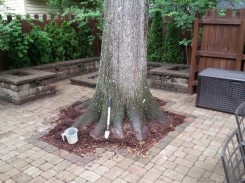
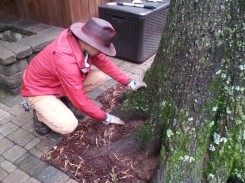
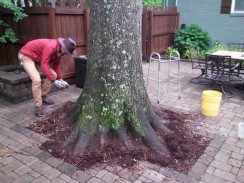
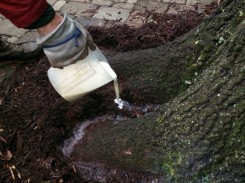
Shrub Doctor was given a unique challenge yesterday with providing a long-term sustainable solution for this Willow Oak tree. The tree has no space to grow in this backyard patio area. Shrub Doctor’s solution was a tree growth regulation treatment. This treatment reduces the growth of the tree’s canopy and redirects its energy towards the production of a more fibrous root system. More fine roots mean more nutrient uptake, and a more efficient ability to absorb moisture. With its limited area for both, this tree needs all the help it can get. If you have a tree in a restricted area give Shrub Doctor a call. Our certified arborists will evaluate your tree and provide you with a long-term solution that provides a more sustainable future for your tree and landscape.
Posted in Around Your Neighborhood | Tagged certified arborist charlotte, Certified ISA arborist, Charlotte arborist, Charlotte tree and shrub care, Charlotte tree health, Charlotte trees, Myers Park, Myers Park Oaks, Shrub and tree care Charlotte | Leave a Comment »


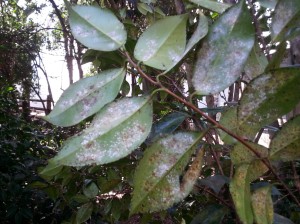 We took the opportunity the other day to treat a grove of huge camellia shrubs that were infested with scale insect activity. Shrub Doctor has had great success killing scale infestations with horticultural oil and our backpack fogging machine. We blast the oil into the canopy of the shrubs suffocating the scale. We have used this non-toxic method to control scale activity with our customers for many years. If you have a scale insect problem, call Shrub Doctor at 704-920-0290. We will promptly visit your landscape and get your landscape back in control.
We took the opportunity the other day to treat a grove of huge camellia shrubs that were infested with scale insect activity. Shrub Doctor has had great success killing scale infestations with horticultural oil and our backpack fogging machine. We blast the oil into the canopy of the shrubs suffocating the scale. We have used this non-toxic method to control scale activity with our customers for many years. If you have a scale insect problem, call Shrub Doctor at 704-920-0290. We will promptly visit your landscape and get your landscape back in control.
Posted in Organic Plant Health | Tagged Ballentyne trees, certified arborist charlotte, Charlotte NC trees, Charlotte shrub care, Charlotte tree health, Diseases of shrubs, Organic shrub care Charlotte | Leave a Comment »
The late winter season is a great time to transplant your dogwood trees. Shrub Doctor moved this tree just the other day. We made a sequence of photos to record the proper procedures that we use to assure a successful transplant. The first photo shows where we severed the roots for easy removal. We next found some great organic compost right under a willow oak, at the back of the property. This compost was mixed with the clay soil removed from the new tree site. Note how we added a few rotting limbs to the bottom of the hole to help improve the fungi populations in the soil. You can find earlier posts that describe this procedure in more detail. We next fertilized the tree with our special blend of poultry manure and completed the planting with a slow deep soaking of the tree. We will continue to perform this same watering procedure about three times a week until we feel the tree can make it on its own. If you have any questions about transplanting your trees or shrubs give Shrub Doctor a call at 704-920-0290. We’ll be glad to give you advise to assure that you too have a successful day in your garden.
Posted in Around Your Neighborhood | Tagged Ballentyne trees, Certified ISA arborist, Charlotte arborist, Charlotte NC trees, Charlotte shrub care, charlotte street trees, Charlotte tree and shrub care, Charlotte tree health, Charlotte trees, Deep Root Fertilization, Myers Park Oaks, Myers Park Trees | Leave a Comment »

If you notice the leaves on your plants curling don’t be alarmed. By curling its leaves, this shrub reduces its chance of loosing moisture from the cold and dry winds. As soon it begins to warm, the foliage will return to its normal shape. Winter leaf curl is common with rhododendron and laurel shrubs, so don’t be alarmed if your camellia shrubs show this same condition as well.
Posted in Around Your Neighborhood | Tagged Charlotte shrub care, Charlotte tree and shrub care, Freeze damage to plants, Shrub Doctor, Winter leaf curl | Leave a Comment »
Never under estimate where you might find great organic mulch around your house. The decaying leaf matter in your gutters can be spread around your shrubs to provide them a rich food source.
Posted in Around Your Neighborhood | Tagged Ballentyne trees, Boxwood care Charlotte, Charlotte tree and shrub care, Myers Park Trees, Shrub and tree care Charlotte, Shrub Doctor Charlotte, Sustainable landscaping, Sustainable organic shrub care | Leave a Comment »

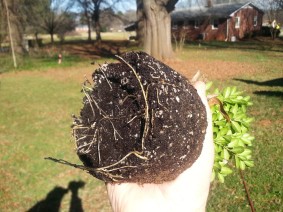
 Shrub Doctor took advantage of the awesome warm weekend to transplant several boxwood shrub cuttings that we propagated this past Spring. The cuttings were simply inserted into nice organic soil and left to establish roots. We periodically drenched the cuttings with our sea kelp and liquid worm casting solution that’s used in our annual organic shrub and tree fertilization program. Just look at the root structure of this shrub. We can now re-pot these cuttings into larger containers so they will continue to grow into large healthy plants. The last photo shows these cuttings aligned to the south facing winter sun. They will enjoy nice warm sunshine throughout the next few months. When hot weather arrives we will move these boxwoods into a more protected area so they will continue to grow with minimal stress from intense summer heat and sun. To learn more about how Shrub Doctor can improve the health of your plants call
Shrub Doctor took advantage of the awesome warm weekend to transplant several boxwood shrub cuttings that we propagated this past Spring. The cuttings were simply inserted into nice organic soil and left to establish roots. We periodically drenched the cuttings with our sea kelp and liquid worm casting solution that’s used in our annual organic shrub and tree fertilization program. Just look at the root structure of this shrub. We can now re-pot these cuttings into larger containers so they will continue to grow into large healthy plants. The last photo shows these cuttings aligned to the south facing winter sun. They will enjoy nice warm sunshine throughout the next few months. When hot weather arrives we will move these boxwoods into a more protected area so they will continue to grow with minimal stress from intense summer heat and sun. To learn more about how Shrub Doctor can improve the health of your plants call  1-888-2GO-ORGANIC (1-888-246-6782) One of our certified arborists will be glad to visit and explain how our annual organic shrub and tree program can restore the faith in your landscape.
1-888-2GO-ORGANIC (1-888-246-6782) One of our certified arborists will be glad to visit and explain how our annual organic shrub and tree program can restore the faith in your landscape.
Posted in Around Your Neighborhood | Leave a Comment »

















